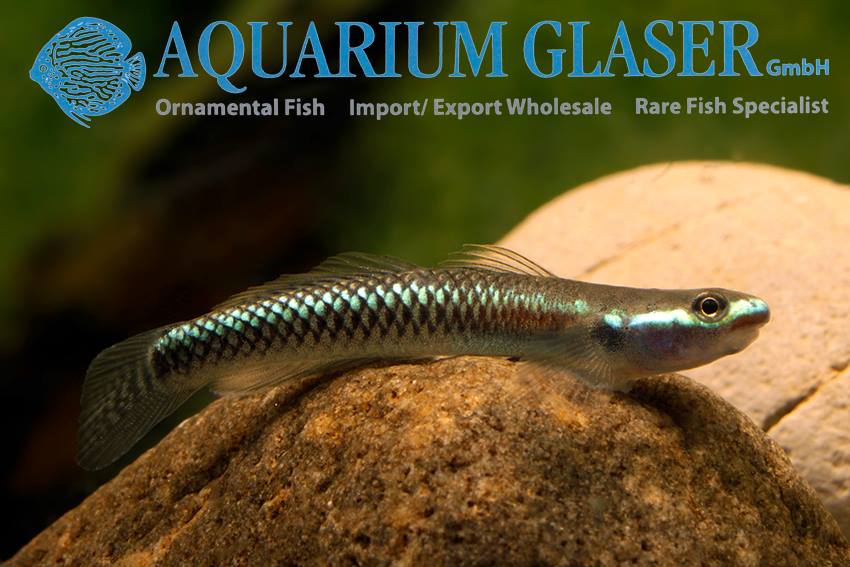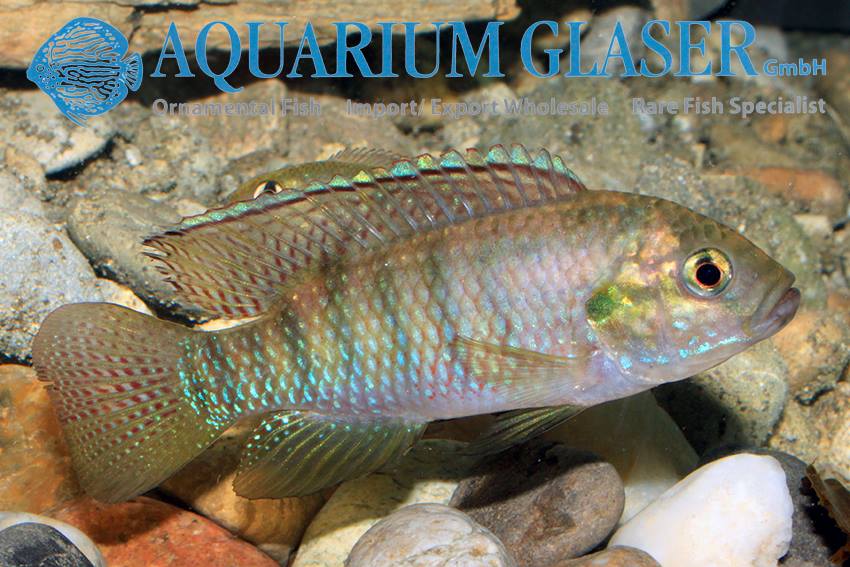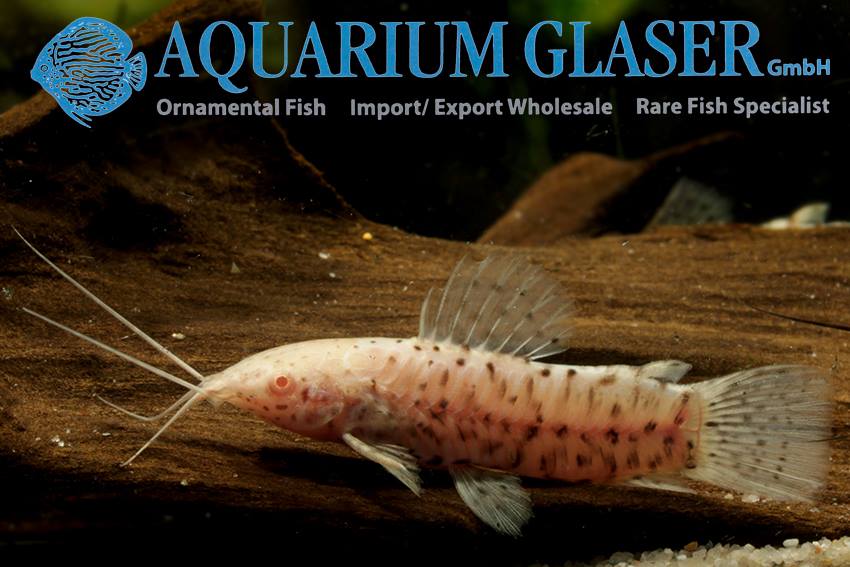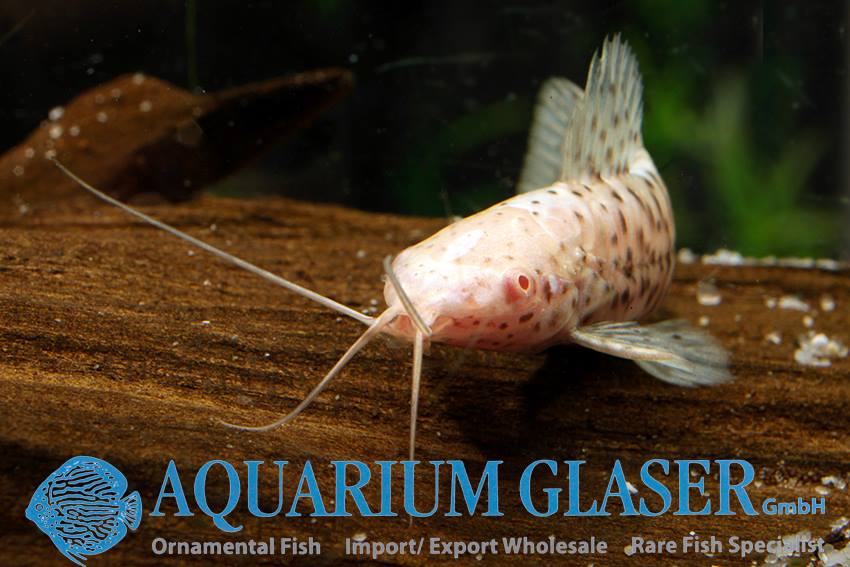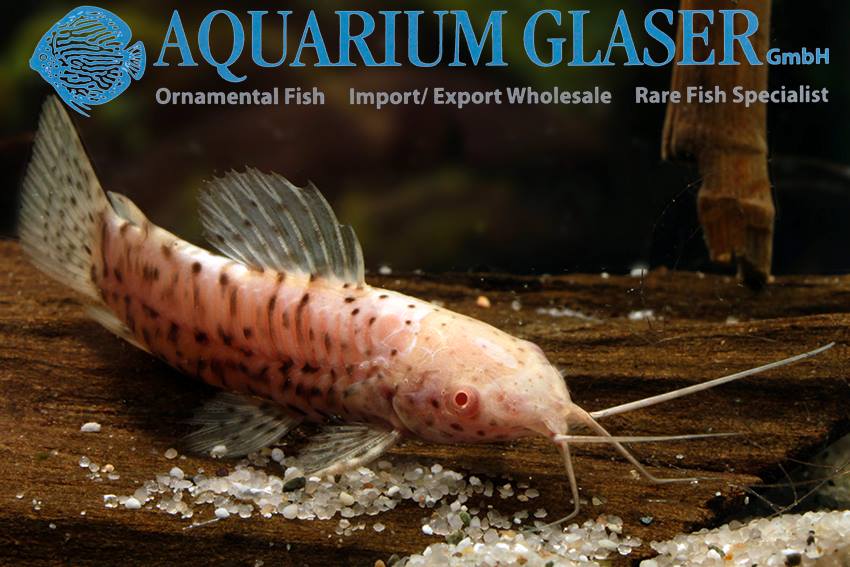
As each month we present the most popular fish imports sponsored by Aquarium Glaser!
Pao abei (formerly: Tetraodon or Monotrete abei)
In Southeast Asia a group of freshwater puffers exists that is extremely difficult to tell apart on a specific level. They are called the Eyespot-Puffers or the Pao-leiurus-complex. These puffers live in streams and rivers, some also in ponds and lakes, always in pure freshwater.
Among the most enigmatic species is Pao abei, which has been described scientifically in 1998 from the Mekong river in Laos. Preserved specimens are very dark, almost black, with tiny yellow or orange spots. This was exactly how the fish looked on the photos that were sent to us by our supplier from Thailand! But the fish he sent look very different when kept in aquaria. This is the tricky thing with freshwater puffers: they can change their coloration very fast and very drastically. Additionally every individual has a slightly different pattern. There are only very few constant anatomical features that allow a determination, most of them overlap in the different species. So, do the fish we could recently import – they have a size of 7-10 cm – really belong to the species Pao abei? Who knows… Anyway, they are beautiful and interesting fish!
Hemiodontichthys acipenserinus
This species has been named “Pinocchio cat” in the trade due to its funny looking nose. The species represents the smallest of all mouthbrooding whiptail cats – it usually grows only to 10 cm total length in aquaria – and is thus very well suited for keeping. We currently were able to import these beautiful animals once more from Peru.
The fish are – as already mentioned – mouthbrooders, the male takes care for the eggs. We are very happy that one of our males currently bears a batch of eggs. Of course, we are a wholesaler, not a breeding station, but nevertheless this shows us that our fish really feel good, for otherwise they would not breed at all.

Mastacembelus sp. „Nargis“
We could import this new discovery – a spiny eel – for the first time now from Burma. Initially I thought it would be a member of the M.-armatus-group, but the specialist for spiny eels, Ralf Britz from Natural History Museum in London led me to the idea to take a closer look on the caudal fin. Indeed this fin is fairly separated from the dorsal and the anal fin in Mastacembelus sp. „Nargis“ , while it is merged with these fins in the M.-armatus-group. Ralf thinks that M. sp. Nargis is closest to M. caudiocellatus, but of course he also says that more and detailed observations have to be done to proof this. In the meantime it is best to name the fish Mastacembelus sp. „Nargis“.
It is much likely that Mastacembelus sp. „Nargis“ belongs to the medium sized members of the #genus and will attain a maximum length of about 25 cm or so. Our (short) experience with the fish shows that it is as peaceful, gregarious and secretly as one expects from a member of this relationship.
Stiphodon semoni
Once more we were able to import one of the gorgeous #gobies belonging to the genus Stiphodon. This time we most likely received Stiphodon semoni, a species that is known for a long time already scientifically. It has been described already back in 1895. The species has a wide distribution, it is known from Sulawesi, Bali, New Guinea (Irian Jaya), generally in Indonesia, in the west to the Solomon Islands. The larvae of this species develop in marine environment, so the wide distribution is not so astonishing. The adults are strictly freshwater fish that prefer clear, small streams.
The members of the genus Stiphodon are in general termed as „neon gobies“, but this fits especially for S. semoni. Keeping these fish is pretty easy, Stiphodon are very peaceful fish. They should be kept in groups. In that case they show a lot of interesting behavior. The bottom of the tank should be furnished with round river stones of about 6-8 cm diameter, and portions of sandy bottom. Of course these current loving fish should have a good filtration in their tank. The water temperature can be between 24 and 28 °C.

Cichla orinocensis
We currently have this amazing large cichlid in stock. The specimens originate from Venezuela and are 16-18 cm long. They are in perfect condition and very good acclimatized.
One can observe the unique sexual dichromatism of Cichla orinocensis in this size: males look rather like Cichla ocellaris, while females have a color pattern that reminds one in C. temensis.
Cichla orinocensis is a typical member of its genus and can reach a maximum size of about 70 cm. Maturity is usually attained at a length of 15-25 cm. All species of Cichla are – as far as it is known – openbrooders and perform a bipartental brood care.
Youngsters can be fed with white mosquito larvae and bloodworm; however, feeder fish are ideal. From a size of about 10 cm on the young Cichla can be fed with frozen smelt as the basic food. Smelt can be used even for largest specimens.
Tilapia ruweti
This dwarf cichlid originates from Western Africa. Tilapia are usually large and delicious food fish. But T. ruweti grows only to a length of 8 cm (rarely up to 10 cm) and so the species really can be termed “dwarf cichlid”.
However, it is necessary to mention that – like all its congeners – Tilapia ruweti is a vegetarian. Although all types of fish food are taken readily under aquarium conditions, the fish also will feed on all soft aquarium plants.
Regarding water chemistry the fish is completely undemanding. T. ruweti are open brooders, they should be kept at 22-24°C and for breeding at 26-28°C.
Myleus schomburgkii
This is one of the most beautiful of the large tetras: Myleus schomburgkii. The magnificent species reaches up to 45 cm in total length. The photos of the juveniles illustrating this entrance are made from our imported specimens, while the adults have been photographed in a public aquarium.
In contrast to many other species of silver dollars identification of Myleus schomburgkii is quite easy. It is the only species that has a vertical black stripe on the body. However, shape and size of that stripe differ in specimens from different localities so it is possible that more than one species is currently lumped under the name of M. schomburgkii.
Sexes cannot be distinguished in juveniles externally, but can be very easily distinguished in adults. In all Myleus species adult males developed a two-lobed anal fin. In M. schomburgkii the males moreover develope filiformous extensions of the dorsal fin rays. Mating males become splendid red.
These close relatives of the piranhas feed mainly on plant material. Exactly like piranhas Myleus schomburgkii establish a hierarchy. The species is one of the most attractive inhabitants of large aquaria one can think of.
Megalechis thoracata „Albino“
The Port Hoplo Megalechis thoracata – maybe the synonym (now invalid) name Hoplosternum thoracatum is more familiar to some readers – is one of the earliest aquarium fish at all. The fish has only one real disadvantage: the maximum size, which is about 15 cm (or sometimes even larger). However, the species has a comparatively small mouth and so it fits quite well in a community tank with more robust and somewhat larger fish. Megalechis have a great fan community who calls them the „fighting sausages“.
Breeding Megalechis is very interesting, for male Port Hoplos build up a foam nest, similar to that known from anabantids. Megalechis prefers to build it under a swimming item (breeders often use the covers of old coffee boxes, but this is hardly ever available in the wild). The male is very pugnacious while guarding the nest and will even jump in the keeper´s face if this curious person comes too close to the nest!
Until now no artificial sports became known from Megalechis. But now we obtained from a breeder an albino sport. These animals look very attractive. We wanted to make also photos from „regular“ Port Hoplos for comparison and while looking through the animals we have in stock we also found two almost black animals! This is quite astonishing after decades of keeping and breeding Megalechis without such mutations!
Anzeige




































